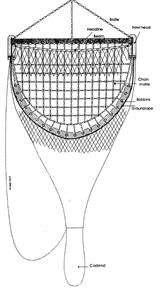|
Beam trawls are designed for use on the seabed.
The narrow mouth of the trawl is made up of a rigid beam
along the top, and two skids to either side. To catch flat fish,
heavy 'tickler chains' are suspended along the bottom of the mouth.
They can penetrate the seabed to depths of up to10 cm, and the trails may remain as 'plough marks' for many years. Beam trawlers will often “re-run” tracks to catch scavenging fish attracted to the area. In stony areas in the North Sea, chain mats are used to stir up the fish and to prevent stones from entering the net.
An area, equivalent to
48% of the North Sea,
is disturbed annually
by beam trawling. It is
concentrated in the
south, reaching 54%
off the English coast,
112% in the central
southern North Sea,
153% off the Danish
coast, and 321% off
the Dutch coast.
Beam trawling is a
non-selective fishing
method. Many
non-target species are
taken, resulting in high
levels of discards.
In 1990, an estimated total of 800,000 tonnes of fish,
invertebrates and offal were discarded in the
North Sea alone. More than 70% of discards consisted
of demersal roundfish and flatfish.
Approximately half of the discards occurred in beam
trawling fisheries.
(MegaPesca Final Report, June 1999).
http://www.europarl.eu.int/stoa/publi/98-17-01/default_en.htm
http://europa.eu.int/comm/fisheries/doc_et_publ/liste_publi/studies/biological/1309R03B_index.htm#by-catch/discards
A 1994 FAO Fisheries Technical Paper suggested that total costs of bottom fish discarded in the North Sea, could have approached the value of landed catch (approximately 470,000 tonnes with an estimated first sale value of 700 million euro in 1997).
Double-rig beam trawlers tow two trawls, one from either side. This technique is used in the shrimp and flatfish fisheries in the North Sea.
In a 1996 pan-European discard study, it was shown that in the levels of discards in the EU Crangon (a brown shrimp) fishery, were unacceptably high.
In one year, the numbers of juvenile fish discarded were:
Plaice 928 million juvenile fish discarded.
Sole 16 million juvenile fish discarded
Cod 42 million juvenile fish discarded
Whiting 55 million juvenile fish discarded.
|
.gif)



